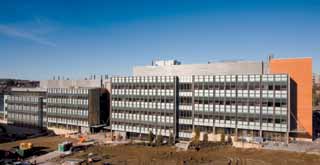
DJC.COM
March 2, 2006
Public spaces put a friendly face on lab building
CO Architects

Stazicker
|
The University of Washington has constructed a new center for the disciplines that lead the evolution of biomedical research — bioengineering and genome sciences.
The completion of the new William H. Foege Building stands as a symbol of the University of Washington's commitment to the exploration of these emergent sciences and also to the collaboration and cooperation that characterize such advanced programs. The Foege Building is one of a very few such facilities designed and built to support such cutting-edge research.
Work nears completion
The Foege Building is particularly significant for the UW Department of Bioengineering, as it provides a central home for its important teaching and research programs. For many years the department's faculty, staff and students have been working in multiple buildings spread out across the campus.
The department has a rich history. The work of its researchers has led to many important discoveries such as the development of medical ultrasound technology, surgical robotics, "smart" biomaterials and high-performance computing. The bioengineering department is also a national leader in technology transfers and corporate research partnerships.

Photos by Lara Swimmer Photography
UW's Foege Building, under construction, has a long circulation spine that connects three public levels and serves to draw visitors through the building.
|
The UW Department of Genome Sciences originated in September 2001 with the fusion of the departments of genetics and molecular biotechnology. In 2003, the university brought in Dr. Robert Waterston, one of the key architects of the Human Genome Project, to set up its newest department.
Also in 2003, the university announced a $70 million gift from the Bill & Melinda Gates Foundation that would further enhance the university's position in genome sciences research.
Most of the gift — $60 million — was earmarked for construction of new, critically needed research space for the genome sciences. The balance was to be applied to collaborative global health programs at the UW related to genome sciences.
The university has received additional funding from the federal government, the Whitaker Foundation, and from other foundations and private donors to support the new 260,000-square-foot, $150 million facility, which has been designed as two adjoining and linked buildings and will support cross-disciplinary research. Ground was broken in 2001 and construction is now nearing completion.
New quadrangle
The Foege Building forms the western edge of a new quadrangle fronting the UW health sciences campus, and thus creates a landscaped vista that visually connects the historic central campus with Portage Bay.
The building is separated into two wings, one serving bioengineering, and the other, genome sciences. A main entrance located in a courtyard between the wings forms a major portal leading through the quadrangle to the Health Sciences Building and Medical Center.
Both wings follow a similar plan organization, with laboratories located along 15th Avenue and Pacific Street, and faculty offices facing the landscaped quadrangle, Portage Bay and Mount Rainier.
Both have a similar layout for infrastructure and use the same types of equipment to reduce maintenance costs and allow systems interoperability.
But while bioengineering consolidates and expands the university's undergraduate and graduate teaching and research programs, genome sciences is devoted solely to research. Therefore, laboratories were designed to accommodate the differing methods of research between the two departments.
Diff. programs, diff. needs
In bioengineering, teams are led by principal investigators who direct work on their individual projects. As a result, laboratories are dedicated for each investigator and organized into clusters surrounded by their adjunct support spaces.
Each lab is outfitted with a robust infrastructure to support a variety of multidisciplinary activities such as tissue culture, microscopy, lasers, specialized instrumentation and cold rooms. For consideration of safety, undergraduate bioengineering students work in spaces segregated from the main labs but connected visually with large windows.
Genome sciences is organized on an institute model in which large, multidisciplinary teams of investigators work on individual aspects of common projects. Therefore, communication between team members, and the ability to change the uses of the labs regularly, are essential.
In response, labs have been designed as large open lofts allowing researchers to circulate from one lab to another along an open walkway within the labs. Support labs are located along the same walkway so they can be accessed from the labs or the main corridor, reducing redundancy of equipment and promoting staff interaction.
Wet services are only located on walls along the open walkway and the central core, leaving the loft area unencumbered by piping. A variety of moveable modular work benches and computation workstations allow the labs to be rearranged easily by connecting them to power and data umbilicals that are set out in a regular grid throughout the loft.
Interaction encouraged
In both departments, promoting interaction between staff was an important goal.
Informal seating areas equipped with white boards and kitchenettes are located at the center of each floor adjacent to stairs and elevators, and there is a 200-seat auditorium for colloquia.
By virtue of its form and siting, the Foege Building creates an internal circulation spine that connects three public levels and encourages the campus community to be drawn through the building.
The building reaches out to the larger campus community with amenities such as the 200-seat auditorium and a 200-seat cafe and noodle bar overlooking Portage Bay. Atria, reading spaces, lounges and conference rooms provide opportunities for chance conversations and planned collaborations among researchers, faculty and students.
The Foege Building fulfills an intensive program and makes full use of a hillside site that drops 45 feet from the central campus edge to the water's edge of Portage Bay.
Externally, the building's fabric addresses the transition between the architecture of the central campus and the marine environment of Portage Bay.
On the outward-facing west façade — the public face — the building is sheathed with terra-cotta tiles that reinterpret the brick vernacular of the central campus buildings. The interior elevations — forming the new campus quadrangle — are transparent and clad completely in glass, adding sparkle and movement to this outdoor gathering space and providing light, views and a connection to nature.
The conference rooms and shared spaces offer views to the surrounding lakes and mountains, reminding the university community of the natural significance of the region in which it is fortunate to reside.
Peter Stazicker, senior principal of CO Architects in Los Angeles, has over 35 years of experience with science and technology, health care and academic facilities for both public and private institutions.
Other Stories:
- Biotech developers are going green
- WSU looks to ramp up biotech development
- Biotechs differ in needs for space and power
- UW's first DBOM building almost done
Copyright ©2009 Seattle Daily Journal and DJC.COM.
Comments? Questions? Contact us.